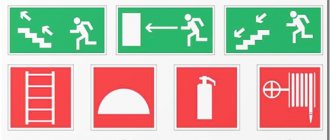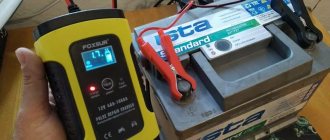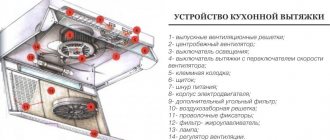- home
- Basic knowledge
The main purpose of electrical safety signs is to protect the user and anyone else who may be harmed as a result of equipment failure or malfunction from electric shock. In addition, safety posters prevent actions that lead to breakdown of devices and also serve to indicate the workplace.
The classification accepted today divides electrical safety signs used on electrical installations and in the area where they are located into the following types:
- according to the nature of the recommendations: warning signs;
- prohibition posters;
- prescriptive;
- indicating signs.
- permanent, installed directly on equipment and electrical appliances, their components and adjacent structures;
The image of each sign is regulated by state standards that determine the color of its parts (border, edging, background), shape, size and motto - text that carries key information.
Prohibiting
As is clear from the name of the category, prohibitory signs and posters must be used in cases where unauthorized actions could lead to voltage entering equipment or a voltage workplace. In addition, they are used to prevent employees from walking in work areas without special protective equipment.
“DO NOT TURN ON people working”
The prohibitory inscription is written in red in the center of a white sign with a red frame. Such posters are placed on electrical installations (from 1 kilovolt) - on switches, disconnectors, keys and other load supply devices, and on switching equipment, the erroneous activation of which will lead to the transfer of voltage to the site of installation or repair work.
"DO NOT ENABLE line work"
Red poster with white border. The prohibitory inscription is written in white letters in the center. Intended for use in the same conditions, however, this sign is located on the switching and closing devices of switching electrical installations to prevent the supply of load to the overhead lines during repair and installation work on them.
“People are working NOT OPEN”
Portable poster with dimensions 200˟100mm, has a white background with a red border. The inscription is written in white or red font. Installation of this sign is required in situations where the opening of pneumatic actuators and air ducts used in electrical installations of power plants could lead to the supply of hydrogen, compressed air or carbon dioxide, which is hazardous to health, to the people performing the work.
“Do not switch ON OPERATION UNDER VOLTAGE again!”
Letters in red or black on a white background with a red frame. This sign is used in situations where attempts to manually restart high-voltage lines after they have been automatically turned off should not be allowed. It is installed on switches, separators, keys and other similar devices during the repair of high-voltage live lines. Turning on the line after automatic shutdown must be agreed upon with the person making the repairs.
"DANGEROUS! ELECTRIC FIELD!"
These prohibition signs are large in size - 130˟240 mm, and are made in the form of a red inscription on a white background with a wide red frame. They are hung in open switchgears with voltages above 330 kV (the sign should be at a level of 180 cm from the ground). Personnel are prohibited from being in the area of an active electric field without special protective clothing. Some sources classify this sign as a warning sign.
Types of electrical safety signs
- Prohibiting. It is prohibited to work near operating power plants, and it is prohibited to turn on or off switching devices.
- Warning. These signs indicate that there are non-insulated, live parts of electrical installations nearby. Touching them is deadly.
- Prescriptive. These posters inform you that electrical work is allowed in this location only with all safety precautions and strict adherence to safety rules.
- Index marks. Similar signs indicate those electrical installations that are connected to a ground electrode.
Second subgroup:
- permanent;
- portable.
Prohibitory signs
Sign: “Do not turn on. People are working." The poster is presented in a rectangular format. Installation is carried out near electrical devices. For voltages above 1 kV, signs are placed near the wires to which high-voltage switching devices are connected, which are necessary to create a visible break during repair work on high-voltage equipment.
In networks below 1 kV, banners are placed near switches and circuit breakers.
If there are no switching devices, then before repair and installation work you should remove the fuses and install indicating posters.
A sign indicating that repair and installation work is being carried out on the lines is indicated as follows: “Do not turn on. Work on the line." During this work, turning on switches or switches is prohibited.
A sign indicating that people are currently working in this place: “Do not open. People are working." The sign informs about the prohibition of any actions that could open access to gas.
Sign “Work under voltage. Do not turn on again" informs that it is strictly prohibited to turn on the switching device again without the appropriate permission.
There are cases when high-voltage circuit breakers are rejected by relay protection devices due to the occurrence of short circuit current. In this case, you need to determine the location and cause of the damage. Next, you need to eliminate it, after which the maintenance personnel checks everything. And only after approval from senior management can the equipment be put into operation.
Warning notices
A “Caution Electrical Voltage” sign informs you that there is a high voltage installation nearby. Therefore, strangers are prohibited from being in this place. Such posters are mounted near electrical technological installations that are energized.
The sign is highlighted in bright yellow.
The "Caution Electrical Voltage" sign also indicates high voltage. A similar designation sign is installed on high-voltage supports.
The “Stop Voltage” sign informs about the presence of electrical installations whose voltage is quite high.
Sign "Test. Danger to life" reports that electrical tests are being carried out at this location.
The sign “Do not enter, it will kill you” informs that high-voltage equipment is located in this area. Touching its metal parts is fatal. Climbing onto technical equipment is prohibited.
The “Dangerous Electric Field” sign informs you that it is prohibited to be in this room without special protection.
Such banners are mounted next to equipment designed for voltages above 330 kV.
Mandatory signs
These posters indicate the work area for technical personnel.
A “Work Here” sign shows the employee that work can be done in this location. Most often, this poster is mounted next to the technician’s workplace.
The sign “Get in here” shows you the most correct, correct and safe path through the stairs that will lead you to your personal place. Such a sign can be installed next to a stationary staircase.
Information signs
In reality, there are a lot of signs prohibiting and permitting certain actions near electrical installations.
In our article we will try to list the most basic ones.
The “380 V” sign indicates that the three-phase voltage in the system is 380 volts.
Educational signs: “Stop the tension”, “Don’t get involved! He will kill." In most cases, these signs are hung in schools, kindergartens, and offices.
The sign “There is no toilet here, but there is 380 V” informs that electrical devices are installed in this place, their voltage value is 380 volts. The presence of outsiders is prohibited here.
Directional signs
The “Grounded” indicator informs you that it is prohibited to redistribute voltage to any separate grounded area.
The indicator is mounted next to high-voltage switches, near its drives.
During installation or dismantling of electrical equipment for its repair or replacement, it is necessary to strictly comply with all safety requirements, all necessary posters must be installed, because people’s lives depend on all these measures.
Only strict compliance with all the rules will help get rid of many problems and accidents at work.
Neglecting safety rules is strictly prohibited; failure to comply with the rules and requirements is subject to criminal liability.
Warning
Warning posters are designed to inform people of the risk of being near apparatus or equipment that, if energized, could cause injury. In addition, they are hung in situations where it is necessary to exclude the possibility of activating separators, buttons, switches, keys and other switching devices in electrical installations in order to avoid supplying voltage to the electrical equipment on which work is being performed. Also, warning posters are placed during repairs and other work to remind about the rules and requirements of electrical safety.
Two danger symbols
A permanent sign, depicted as a yellow equilateral (36 cm) triangle with a black border, on which a black lightning bolt is depicted. Serves to alert you to the potential danger of being in a certain place or to prevent any other actions. They are hung on the doors of electrical installations and equipment of any voltage class, and in the security zone of cable lines.
A permanent sign, distinguished from the previous one only by a white background. It is installed for the same purpose on concrete enclosing structures of open switchgears and reinforced concrete supports of high-voltage power lines.
STOP! VOLTAGE
A portable rectangular sign with a black inscription and an image of a lightning bolt (according to GOST R 12.4.026). Used on electrical installations of various voltage classes. In conditions of repair or installation work - on the fences of the working area and adjacent chambers.
TEST is life threatening
Portable poster with black inscription and an image of a red lightning bolt on a white background with a red border. Serves to alert you to the risk of electric shock during high voltage testing. During preparation for testing, posters are placed directly on the equipment and its enclosures.
Danger! Keep out
A portable sign indicating the risk of walking and walking on structures leading to live parts of equipment. It is made in the form of a black inscription and a red lightning bolt on a white plate with a red frame.
Product classification
Posters and signs warn of the dangers associated with approaching energized equipment. Safety posters may also identify the workplace.
Based on the nature of their application, electrical safety posters are divided into portable and stationary (permanent).
Classifications of posters and signs:
- Prohibiting,
- Warning,
- Prescriptive,
- Pointing.
All signs and their sizes, more details about each type of sign are written below in the article
Prohibiting
Designed to prohibit switching with devices (turning on or off), they are needed so that no one mistakenly applies voltage to electrical equipment. The inscriptions are made in red letters on a white background and with a red frame, or vice versa in white letters on a red background.
Dimensions of rectangular posters (width x height): 200x100 or 100x50 mm.
Prohibition posters
Warning
Designed to warn of approaching live parts or parts at a life-threatening distance. Signs are used in electrical installations up to 1000 V and above.
The inscriptions are made in red letters on a white background and with a red frame, or a yellow triangle with a black frame and a zipper, or black paint, which is applied to reinforced concrete supports, fences or slabs.
Dimensions of rectangular signs: 300x150. The dimensions of the sides of the triangle are usually 300x300x300, but if the sign is used indoors or pasted on equipment, then its side dimensions can be: 25, 40, 50, 80, 100, 150 mm.
Also Read: Power Transformer Maintenance and Repair Warning Signs
Prescriptive
They are used to indicate places of work and for a safe approach to the workplace. The inscriptions and frames are made in blue and white letters.
Sizes of square signs: 100x100 or 250x250 mm, 200x200 and 80x80 mm.
Mandatory signs
Pointing
Indicates that a certain area of the electrical installation is grounded and that voltage must not be supplied to electrical equipment, as well as to indicate the location of various objects and devices. There is only one sign indicating “GROUNDED” in blue on a blue background. Poster dimensions: 200x100 or 100x50 mm The width of the white border should be 5-13mm.
Pointing sign
Prescriptive
Prescriptive posters serve to notify personnel and other people about the places organized for work, methods of access to equipment and actions with it. These are portable signs with a standard size of 100˟100mm or 250˟250mm.
WORK here
It is made in the form of a green (sometimes blue) square with a white circle in the center, inside of which a prescriptive inscription is written in black letters. Intended for use in electrical installations related to electrical stations and substations. Located at the site where installation or repair work is carried out.
CLIMB HERE
The “GET IN HERE” safety sign is made in the form of a green square with a white circle, in the center of which there is an inscription in black font. The poster must be installed on structures and staircases leading to the place of repair or installation work for the safe movement of personnel.
Development of a poster “Electrical safety at home”
MBOU "Vereshchakskaya Secondary School"
Novozybkovsky district, Bryansk region
243015 Bryansk region Novozybkovsky district, Vereshchaki village, st. Kommunisticheskaya 42
Regional scientific conference “Property of the Bryansk region through the eyes of schoolchildren”
Development of a poster “Electrical safety at home”
Authors: Yulia Kuteko and Nadezhda Pylenok, 9th grade students.
Head: teacher of mathematics and physics Shinkorenko M.P.
S. Vereshchaki
2016
annotation
The work “Electrical safety at home” consists of an introduction, the main part, a conclusion and a list of references. The introduction outlines the problem and its rationale. The main part of the work contains an explanation of the causes of electrical injuries in everyday life, introduces the rules for handling electrical appliances and measures to help in case of electric shock. Issues of design and placement of the poster “Electrical safety at home” are also considered.
As a result of work on the project, rules for handling electrical appliances in the house were drawn up; family members of classmates are familiar with these rules; a poster on electrical safety at home was made
- The effect of electric current on living organisms ————————— 6
- Electrical injury ——————————————————————————— 8
- Measures to help in case of electric shock —————————————————- 8
- Main causes of electric shock ———————————————— 9
- Rules for handling household electrical appliances and lamps ——- 10
- Electrical injuries and condition of premises —————————————- 10
- Poster design “Electrical safety at home” ———————————— 11
- Poster location ———————————————————————— 12
- Conclusion. Main results of the work ————————————— 13
- Sources of information (literature) ————————————————- 13
- Introduction. The problem and its rationale.
We all deal with electrical devices all the time. Children and adults often mistreat them, putting their lives in danger. There are known cases of electrical injuries in our area, some of them with a tragic outcome: several years ago a man died in Starye Bobovichi. In Novozybkov last fall, two children were injured by electric shock.
The danger of working with electrical appliances lies in the fact that current and voltage do not have external signs that would allow a person, using the senses (vision, hearing, smell), to detect an impending danger and take precautions. As you know, the human body is a conductor. If someone accidentally touches live parts of an electrical installation, exposed wires or live terminals, an electric current will flow through their body. As a result, a person may receive electrical injury.
Known dramatic cases:
- In one family, the mother left the cord from an electric iron unattended. A small child playing on the floor approached the cord hanging down to the floor and stuck his fingers into the plug sockets removed from the iron contacts. At that very moment he fell dead. (3, p. 10).
- Portable gadgets regularly cause dangerous incidents that cause harm or even death to their owners. Thus, several years ago, a laptop computer caused the tragic death of a young resident of Krasnodar. A powerful electric current struck him at the moment when the 35-year-old Russian was about to look at the pages of a social network. At the same time, he placed the laptop on his lap. Suddenly, a fiery flash erupted from the laptop computer, and in the next second the Russian died from electric shock (5)
- A 26-year-old painter died in the Irkutsk region; his body was found in the bathroom. A man taking a bath dropped his plugged-in laptop into the water, resulting in fatal electric shock (5).
Relevance. That is, the cause of electrical injuries in a peaceful home environment is always an unforgivable neglect of the basic rules of caution when handling electrical appliances. Currently, instructions have been developed for occupational health and safety in various industries. However, there is no compact poster on safety precautions in everyday life. It is advisable to make such a poster (1, p. 102).
Goal: to develop a poster that would allow you to follow the basic rules for the safe use of electricity.
Tasks (aimed at achieving the project goal).
- Study the effects of electric current on living organisms.
- Investigate the causes of electrical injuries in the home environment.
- Familiarize yourself with the rules for handling electrical appliances and lamps.
- Become familiar with measures to help in case of electric shock.
- Study electrical injuries and the condition of the premises.
- Consider the issues of shape, color, clarity of inscriptions and selection of drawings that would be well remembered.
- Discuss the placement of the poster.
Novelty of the work: making a poster on electrical safety at home.
Methods
- Educational and research
- Analysis and systematization
- Comparative
- Conversation
- Broadcasting and design
Personal contribution of the authors: the effects of electric current on living organisms were studied, the causes of electrical injuries in the home were investigated, a poster “Electrical safety at home” was made.
The project “Development of a poster on electrical safety at home” is being implemented as part of the 8th grade physics program on the topic “Electrical Phenomena.”
- Main part
- The effect of electric current on living organisms
The study of the effects of electric current was associated with its influence on a living organism. Italian physician Galvani Luigi (1737-1789) in 1786. discovered "living electricity". He established the occurrence of an electric current in the muscles of a freshly prepared frog when it came into contact with dissimilar metals (iron railings and a copper hook).
The Roman philosopher Seneca (c. 4 BC - 65 AD) wrote about being struck by lightning. Russian academician Richman (1711-1753) died from lightning. The French scientist Marat Jean Paul (1737-1798) studied the effects of electric current on the body. The first works devoted to electric shock date back to the 80s of the 19th century, when the widespread use of electricity in technology began.
The strength of the current, as is known from Ohm's law, depends on the voltage applied to the conductor and its resistance. The resistance of the human body is not always the same and depends on many reasons. If the skin on your hands is rough and oily, then contact with current-carrying wires or machine parts will be poor. There will be a layer of high voltage insulation between the skin and the metal. On the contrary, clean and especially wet hands will create very good contact.
Table (2, p. 44)
| Current strength | Effect of current |
| 0-0.5 mA | Absent |
| 0.5-2 mA | Loss of sensation |
| 2-10 mA | Pain, muscle contractions |
| 10-20 mA | Increasing impact on muscles, some damage |
| 20-100 mA | Respiratory paralysis |
| 100mA-3A | Ventricular fibrillation (immediate resuscitation required) |
| More than 3A | Cardiac arrest (if the shock was brief, the heart can be resuscitated), severe burns |
There have been cases where people who, under the same conditions, received short-term electrical injuries, suffered them differently: some died instantly, others remained alive. It turns out that the outcome is also influenced by at what point in the cardiac cycle (contraction, expansion, pause) the electrical shock acts on the heart.
Life-threatening voltage is 50 V. You should be more careful with secondary current sources that are connected to an alternating current network with a voltage of 36 or 42 V. Particular vigilance is required when operating 42 V. 42 V alternating voltage significantly reduces. But it does not eliminate the risk of electric shock. In the human body at such a voltage, the effect of a non-releasing current can occur with all life-threatening consequences.
- Electrical injury
Electrical trauma is the impact on a person of electric current and voltage that exceeds the maximum parameters in value and duration. These include direct and alternating voltages of more than 36 volts and a current of more than 0.15 amperes. For example, the electrostatic charge accumulated by an artificial fur coat can reach 6000 Volts, but we will only shudder when we feel it, because the current is very weak - thousandths of an ampere. In addition to these parameters, the path of the current through the body is also taken into account: for example, if the current passed through both legs, a person may not even lose consciousness, but if through the left arm and right leg, then even with lower current values, death from cardiac arrest is possible. It is also dangerous for current to pass through the head and limbs when a bare wire falls from above (breakage of a contact or lighting network on the street). Alternating current has a greater damaging power for humans (6).
- Measures to help in case of electric shock.
Symptoms and course. The main damaging effect of current is that it causes shock with loss of consciousness, cessation of breathing and cardiac activity. The second damaging effect is the heat generated when current passes through the body and causes burns and charring (6).
If you suspect an electric shock, you should:
- Free the victim from the effects of current: de-energize the electrical installation that the victim is touching, turn off the switch or fuse, discard the exposed wire with a dry non-metallic object.
- If it is impossible to quickly turn off the current, then you need to drag the victim by his clothes to a safe place (the person providing assistance should wear dielectric gloves or wrap his hands in dry clothes). If a person is lying on the ground, then you cannot approach him with wide steps (there may be a high step voltage between your legs), only shuffling and taking small steps. If the victim is conscious but confused, you can sharply shout “Jump!” cause it to separate from the ground to break the chain.
- Urgently calling a doctor (ambulance), but without waiting for his arrival, you must provide the victim with pre-medical care: put him in a comfortable position, unbutton his clothes and cover him, ensuring complete rest until the doctor arrives (if the victim is conscious). If the victim is unconscious, but has steady breathing and a pulse, you should let him sniff ammonia and spray his face with water.
- If the victim is breathing poorly or not breathing at all, he should immediately begin artificial respiration and chest compressions.
- The main causes of electric shock:
- Malfunction of devices or protective equipment;
- Short circuit of phase wires to ground;
- Violation of safety precautions when handling devices (touching bare wires, fuses, lamp sockets, mistaking a switched-on device for a switched-off one, contact of conductive equipment with live devices) (2, p. 44).
- Rules for handling household electrical appliances and lamps.
The most effective prevention of electrical injuries is the strict implementation of safety rules when operating electrical appliances (2, p. 46).
- When unplugging the cord from the outlet, you must hold onto the plug.
- You cannot go to the switch with wet hands.
- Do not use an electrical appliance with an open coil.
- After finishing work, electrical appliances must be disconnected from the network.
- Do not leave them unattended.
- Place on special stands or on ends if required by operating techniques.
- Regularly maintain household electrical appliances. For this purpose, use special means.
- Do not turn on several high-power household electrical appliances at the same time.
- Place household electrical appliances from walls and other objects at the distance specified in the operating instructions.
- Electrical injuries and condition of premises
It is mistakenly believed that low voltage power sources are safe. But in a bathhouse, damage from a 12V energy source can be fatal for a person. It all depends on environmental conditions and human condition.
It should be remembered that the danger of electric shock awaits us:
- In damp rooms where relative air humidity is close to 100% (basements, baths, showers)
- On metal stairs and reinforced concrete floors; while a person touches metal structures of the building that have connections to the ground (for example, batteries and metal casings of electrical equipment).
Therefore, from the point of view of electrical safety, the premises should be bright, dry and warm. And also have dielectric (wooden) floors, without potholes and cracks. The surfaces of walls, ceilings, doors are smooth and matte. Radiators and pipelines of heating and plumbing systems in the room must be grounded.
- Poster design “Electrical safety at home.”
Discussing the size and shape of the poster, we came to the conclusion that it should be compact and rectangular in shape. (60cm X 40cm, but no more). Main inscriptions: “Be careful with electricity!”, “Don’t”, “Be careful!” do it in red. The rest of the inscriptions are in black on a light background so that they are clearly readable. For drawings, choose bright colors. Then place the entire poster in cellophane or under glass so that it lasts longer. Secure to the wall in the hallway using adhesive tape or a screw.
- Poster location.
In any apartment, each room has a specific purpose. It is difficult for a new object that is not a household item to fit into the environment.
When considering the placement of the poster, we had to take into account the following:
- Most household electrical appliances are located in the kitchen and have to be used there. But most often only the hostess is in the kitchen;
- All family members, entering or leaving the apartment, pass through the hallway.
Therefore, the electrical safety poster should be placed on the wall in the hallway (preferably next to the mirror).
- Conclusion.
When developing the poster “Electrical safety at home” we:
- examined various life situations related to the use of electrical appliances;
- found out what we are doing right and what is wrong in these situations;
- studied the rules for handling electrical appliances that we have in our home;
- introduced these rules to their family members and classmates;
- By making a poster on electrical safety at home and hanging it in our home, in later life we will protect ourselves and our loved ones from the possibility of electrical injury in the house.
It would be useful to know about the help we can provide
victims of electric current.
Having made a poster on electrical safety at home and hung it in
in our home, in later life we will protect ourselves and our loved ones from the possibility of electrical injury in the house.
- Sources of information (literature).
- Technology, labor training, 8th grade, ed. V.D. Simonenko. Bryansk, 1996
- Journal “Physics at School”, N 7 – 2001
- Conversations on physics, M.I. Bludov, M. “Enlightenment”, 1985.
- Physics in drawings, N.S. Beschastnaya, M. “Enlightenment”, 1981.
- https://briansk.ru/world/noutbuk-ubil-sibiryaka-v-vannoj.20131210.306917.html
- https://demo.kurortmag.ru/dictionary/JE/JElektrotravma/
Warning posters
Warning posters warn against approaching dangerous distances from live parts.
“Stop! Voltage" - warns about the danger of approaching live parts of electrical installations that are energized. The poster is used in electrical installations with voltages up to 1000 V and above.
“Don’t get in! Will kill" - this poster warns of the possible approach to live parts that are energized when climbing a structure.
"Trial! Danger to life” - the poster warns of the danger of electric shock during high-voltage tests. Such signs are posted on the fences of workplaces during high-voltage tests.
"Carefully! “Electric voltage” is a sign warning of the danger of electric shock. It is hung in electrical installations of any class and subclass of substations and power plants.










